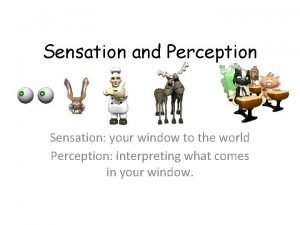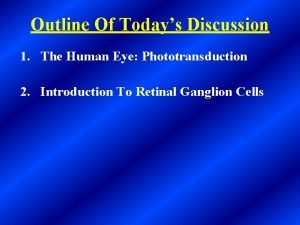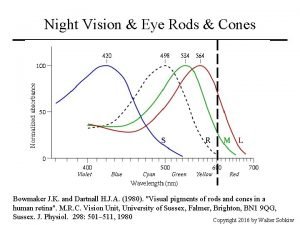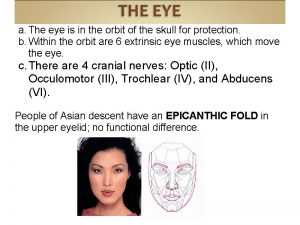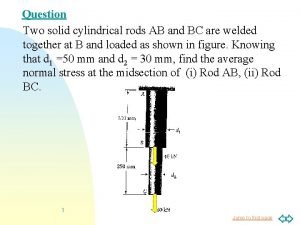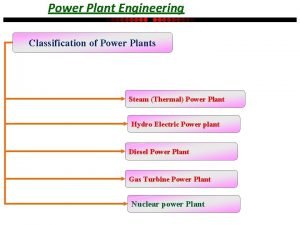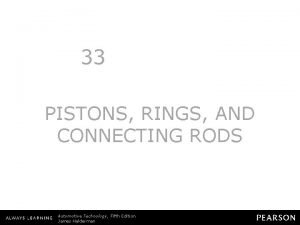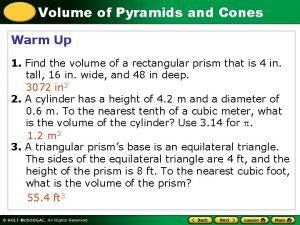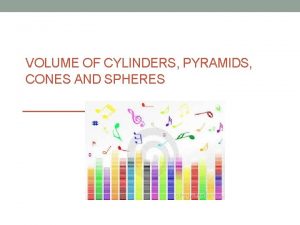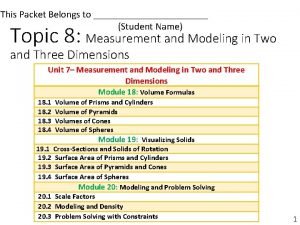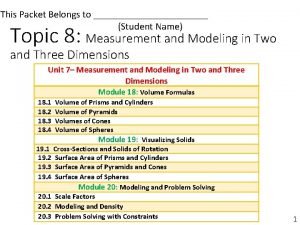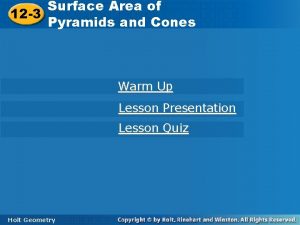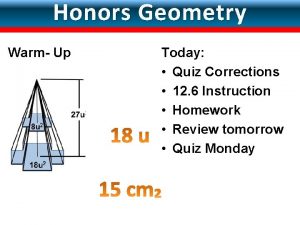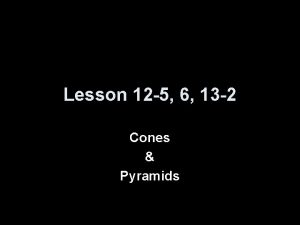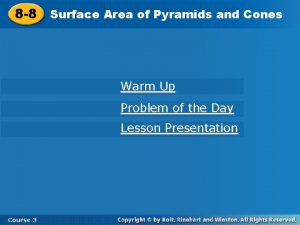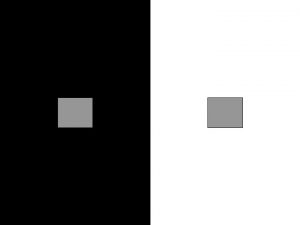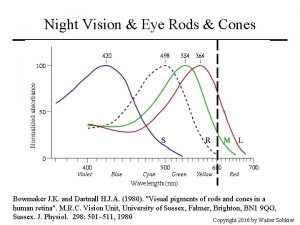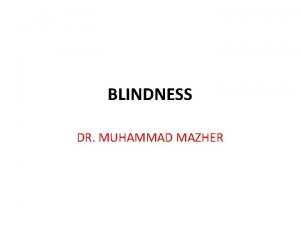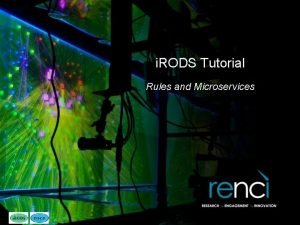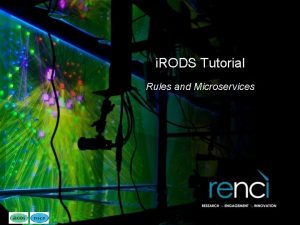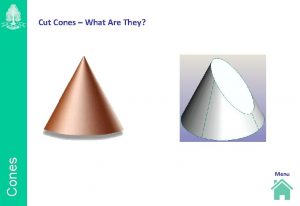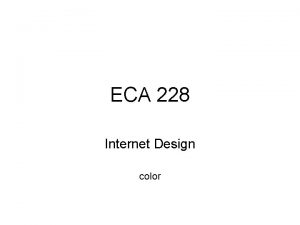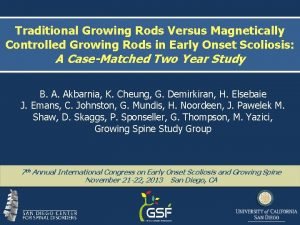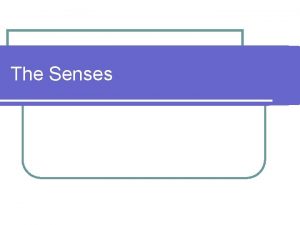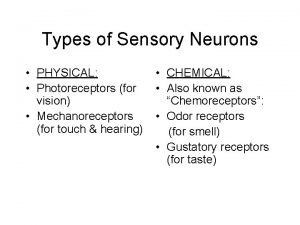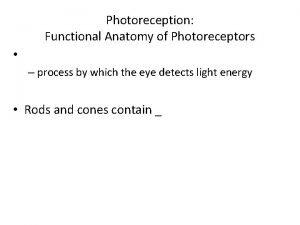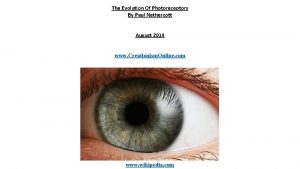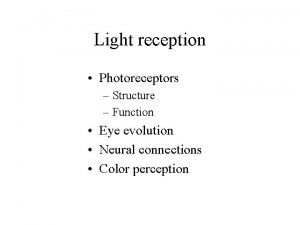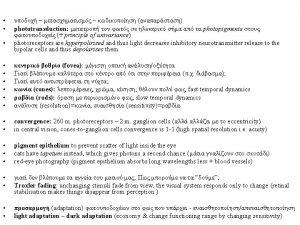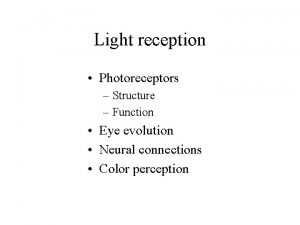1 VISION II 2 Photoreceptors Rods and cones


























- Slides: 26

1

. . VISION -II 2


Photoreceptors (Rods and cones) �Consist of: 1) Outer segment (facing choroid) �Detects light stimulus. It contains visual pigment (iodopsin in cones & rhodopsin in rods) that forms 40 % of this segment. 2) Inner segment �Contains metabolic machinery of cell 3) Nucleus 4) Synaptic terminal (facing bipolar cells) �Transmits signals generated in photoreceptor on light stimulation to dendrites of bipolar cells. 4

5

Rods Cones 120 millions / retina 6 millions / retina At the periphery At Center (Fovea centralis) Rhodopsin pigment Photopsin (3 types). More convergence (200 rods : 1 bipolar) One to one connection More sensitive to light (even to 1 photon). Less sensitive to light. Less accurate (less visual acuity). More accurate (Clear vision) More functioning at night (Scotopic vision) More functioning in day (Photobic vision) Vision in shades of grey Color perception (3 types for Red, Green & Blue)

7

Photopigments �Undergo chemical alterations when activated by light �Consists of 2 components: 1 - Opsin �Protein that is integral part of disc plasma membrane 2 - Retinal �Derivative of vitamin A �Light-Absorbing part of photopigment 8

Photopigments 1 - Rod pigment: �Rhodopsin that Absorbs all visible wavelengths 2 - Cone pigments (color pigments): �Respond v. A selectively to various wavelengths of light. single photon of light can activate a rod whereas several hundred photons are required to activate a cone 9

PHOTORECEPTORS RESPONSE TO LIGHT PHOTORECEPTOR POTENTIAL

Chemical response to light

phototransduction 12

13

14

DARK ADAPTATION v If a person has been in brightly lighted surroundings for a long time and then moves to a dark area, the retina slowly becomes more sensitive to light (a decline in visual threshold). v. Due to regeneration of photosensitive pigments in both rods and cones. Retinal and opsins are converted back into photosensitive pigments (It is nearly maximal in about 20 minutes). v. Regeneration of rhodopsin in rods is completed in 20 minutes. Rods play the major role in dark adaptation.

LIGHT ADAPTATION �It occurs when we shift suddenly from a dark to a bright light place. Immediately, light seems very intense and annoying with reflex closure of eye lids. But within 5 min, normal sensation returns again. �Then the eyes adapt to increased illumination & the visual threshold rises. There is a decline in sensitivity of retina to light. �Due to breakdown of photosensitive pigments in both rods and cones. The photosensitive chemicals are reduced to retinal & opsins (bleaching).

COLOUR VISION �It is the sense of discrimination of various wavelengths of visible spectrum (400 - 700 nm). �Each color has a specific wave length. �Shortest wave length is that of violet color. �Longest wave length is that of red color. �Color vision is mainly the function of Cones (highly developed in fovea centralis).

Trichromatic (=Young-Helmholtz) theory �There are 3 types of cones. Each one is maximally sensitive to one of the 3 primary colors. 1 st cone contains pigment maximally sensitive to blue violet (440 nm). 2 nd cone contains pigment maximally sensitive to green of spectrum (535 nm). 3 rd cone contains pigment maximally sensitive to red of spectrum (570 nm). �Any colored object stimulates the 3 cones but in an unequal manner. Number of impulses arising from these cones to visual cortex differ in frequency according to the color. This difference gives the specific sensation by that color. 18

v Equal stimulation of all 3 cones gives sensation of white. v Color perception is a retinal function. v Color translation is a cortical function (area 17).

COLOR BLINDNESS Causes: • Most commonly hereditary (recessive sex - linked) and affecting males (8%) more than females (0. 4 %). • Very rarely acquired e. g. post encephalitis. • Achromatopsia = color blindness due to lesion in V 8 in visual cortex. Types: According to Young - Helmholtz theory, Color blindness is classified to: 1 -Trichromate: Patient has 3 cones but one of them is weak. �Protanomaly: weakness in red color perception. �Deuteranomaly: weakness in green color perception. �Triatanomaly: weakness in blue color perception.

2 - Dichromate: One cone is totally absent & other two are present. �Protanopia: if cone of red color is absent. �Deuteranopia: if cone of green color is absent. �Tritanopia: if cone of blue color is absent. 3 - Monchromate: �Patient has only one cone system and matches the different colors as various degrees of grey color (cone monochromatism). �Or Patient has no cone system at all color & day blindness (rod monochromatism). Test of color vision: �Ishihara's chart test: Colored printed figures and each figure is printed by different colored small circles on a background of colored circles. 21

v. Red green color blindness is most common. Ishehara Chart 22


Left eye blind Bitemporal hemianopia Heteronymous Homonymous hemianopia with macular sparring

VISUAL CORTEX Area 17 (=Primary visual area) - Concerned with the appreciation of visual sensations. Area 18 (=Secondary visual area/visual association area) - Concerned with correlation and integration of visual sensations. Area 19 (=Occipital eye field) - Concerned with movement of the eye. v In each visual cortex, both the eyes are represented in alternating columns of cells called Ocular Dominance Columns. v Thus corresponding regions of the retina lie side by side close to each other.

26
 The human ability to speedily recognize familiar objects
The human ability to speedily recognize familiar objects Photoreceptors location
Photoreceptors location Rods and cones
Rods and cones Layer of rods and cones
Layer of rods and cones Rods and cones in eye
Rods and cones in eye Dimension of vision
Dimension of vision Cones and color vision
Cones and color vision Cs766
Cs766 Two solid cylindrical rods
Two solid cylindrical rods Difference between moderator and control rods
Difference between moderator and control rods Purpose of a connecting rod
Purpose of a connecting rod Steel rods and pipes on which forms are lifted
Steel rods and pipes on which forms are lifted Pistons rings and connecting rods
Pistons rings and connecting rods Fork and blade connecting rods
Fork and blade connecting rods Practice 10-6 volumes of pyramids and cones
Practice 10-6 volumes of pyramids and cones Volume of pyramids and cones calculator
Volume of pyramids and cones calculator Finding the volume of cylinders pyramids cones and spheres
Finding the volume of cylinders pyramids cones and spheres 11-3 surface areas of pyramids and cones answer key
11-3 surface areas of pyramids and cones answer key 19-3 surface area of pyramids and cones
19-3 surface area of pyramids and cones Pyramid volume
Pyramid volume Surface area of pyramid
Surface area of pyramid Perimeter of cone formula
Perimeter of cone formula 11-3 surface areas of pyramids and cones answer key
11-3 surface areas of pyramids and cones answer key Volume of cylinders, cones, and spheres assignment
Volume of cylinders, cones, and spheres assignment Lesson 3 surface areas of pyramids and cones
Lesson 3 surface areas of pyramids and cones Lesson 12-5 volumes of pyramids and cones
Lesson 12-5 volumes of pyramids and cones Surface area of pyramids and cones
Surface area of pyramids and cones
